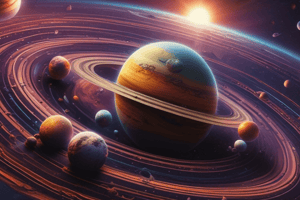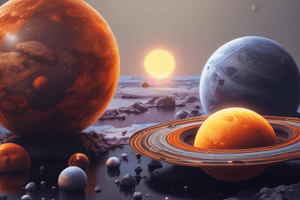Podcast
Questions and Answers
Which planet is the largest in the Solar System?
Which planet is the largest in the Solar System?
- Saturn
- Uranus
- Jupiter (correct)
- Neptune
What is the primary composition of Uranus?
What is the primary composition of Uranus?
- Hot plasma
- Rocky materials
- Mainly hydrogen and helium
- Frozen gases and liquids (correct)
How does Saturn's density compare to Earth's density?
How does Saturn's density compare to Earth's density?
- Less dense than Earth (correct)
- Twice the density of Earth
- Similar to Earth's density
- Denser than Earth
What is the primary source of energy for life on Earth?
What is the primary source of energy for life on Earth?
What characteristic is unique to Neptune among the giant planets?
What characteristic is unique to Neptune among the giant planets?
Which planet appears to rotate on its side due to its unique tilt?
Which planet appears to rotate on its side due to its unique tilt?
What is Pluto classified as?
What is Pluto classified as?
What type of object is a star primarily comprised of?
What type of object is a star primarily comprised of?
What holds everything in the Solar System in place?
What holds everything in the Solar System in place?
What major theory explains the formation of the Solar System?
What major theory explains the formation of the Solar System?
Which planet is known to have a very slow rotation and spins in the opposite direction of most other planets?
Which planet is known to have a very slow rotation and spins in the opposite direction of most other planets?
Which planet is estimated to have 300,000 plant species and supports life?
Which planet is estimated to have 300,000 plant species and supports life?
What characteristic of Mars' atmosphere contributes to its cold and dusty environment?
What characteristic of Mars' atmosphere contributes to its cold and dusty environment?
Which planet appears larger and brighter from its surface compared to viewed from Earth?
Which planet appears larger and brighter from its surface compared to viewed from Earth?
What is the primary gas that makes up the atmosphere of Mars?
What is the primary gas that makes up the atmosphere of Mars?
Which of the following statements is true about the Sun?
Which of the following statements is true about the Sun?
Study Notes
Solar System Overview
- The solar system consists of eight planets, asteroids, comets, and tiny particles that orbit the Sun.
- The Sun, a star, contains approximately 99% of the solar system's mass and its gravity keeps the system together.
Planet Formation
- The nebular hypothesis describes solar system formation from gas and dust around the Sun.
- Developed by Immanuel Kant in 1755 and modified by Pierre Laplace in 1796.
Inner Planets
- Mercury: Closest to the Sun; sunlight is 11 times brighter than on Earth.
- Venus: Second planet; has the densest atmosphere of rocky planets; rotates in the opposite direction and has extremely high temperatures.
- Earth: The only planet known to support life; home to around 300,000 plant species, over 600,000 fungi species, and about ten million animal species. The name derives from an Anglo-Saxon word meaning ground.
- Mars: Fourth planet; cold and dusty with a thin atmosphere primarily of carbon dioxide; features include polar ice caps and canyons.
Gas Giants
- Jupiter: Fifth planet and the largest; a gas giant with over two and a half times the mass of all other planets combined.
- Saturn: Sixth planet; second-largest gas giant with a radius about 9.5 times that of Earth and a very low density.
- Uranus: Seventh planet; a gaseous ice giant that rotates at a nearly 90-degree angle, creating a unique spin.
- Neptune: Outer solar system's other ice giant; contains a hot dense fluid of "icy" materials.
Dwarf Planets
- Pluto: Located in the Kuiper Belt, it is small (half the width of the U.S.) with a moon, Charon, that is roughly half its size.
The Sun
- The Sun is a nearly perfect sphere of hot plasma, generating energy through nuclear fusion.
- It radiates energy mainly as light, UV, and infrared radiation, which is essential for life on Earth.
The Moon
- The Moon's surface features plains, mountains, valleys, and craters formed by impacts from space rocks.
- It orbits the Earth in an oval-shaped path and lacks an atmosphere.
Stars
- Stars are luminous spheroids of plasma held by self-gravity.
- The Sun is the nearest star to Earth and is visible at night alongside many other distant stars.
Studying That Suits You
Use AI to generate personalized quizzes and flashcards to suit your learning preferences.
Related Documents
Description
Explore the fascinating world of our solar system, including the eight planets, asteroids, comets, and more. This quiz covers the formation of the solar system through the nebular hypothesis and delves into the unique characteristics of the inner planets: Mercury, Venus, Earth, and Mars.




